
Unidirectional Ribbon Mic Shootout
Wednesday, October 24th, 2012 | by Randy Coppinger
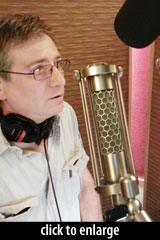 In the $60,000 Ribbon Mic Shootout, we enjoyed a sonic feast of sources and microphones. But two of those ribbons were unidirectional — so different in design, sound, and application that we decided to stage a followup session. We gathered as many unidirectional ribbon mikes as we could find: obscure, discontinued, exclusive, and so new they’d not yet been heard outside the inventor’s lab. And to top it all off we re-enlisted master voice actor and ribbon mic connoisseur Corey Burton. Join us for a listen to the AEA KU4, Oktava ML19, Shure Model 330, RCA 77-DX, Samar Audio AF11 and TF08.
In the $60,000 Ribbon Mic Shootout, we enjoyed a sonic feast of sources and microphones. But two of those ribbons were unidirectional — so different in design, sound, and application that we decided to stage a followup session. We gathered as many unidirectional ribbon mikes as we could find: obscure, discontinued, exclusive, and so new they’d not yet been heard outside the inventor’s lab. And to top it all off we re-enlisted master voice actor and ribbon mic connoisseur Corey Burton. Join us for a listen to the AEA KU4, Oktava ML19, Shure Model 330, RCA 77-DX, Samar Audio AF11 and TF08.
Contents
- Session Setup
- Blind Listening Test – Audio Files
- Listening Notes
- Why Unidirectional Ribbon Mics?
- Conclusion
Voiceover Session Setup
| Date: | October 6, 2012 |
| Location: | Igloo Music Studios, Burbank, CA |
| Recording Engineer: | Ethan Friedericks |
| Microphone Positioner: | Randy Coppinger |
| Voice Actor: | Corey Burton |
Signal Path
Ribbon Microphone Signal Path:
Microphone → AEA RPQ preamp
→ Apogee Rosetta
SM7B Signal Path:
Microphone → Martech MSS-10
→ Avid 192 I/O
- The “Curve Shaper” and EQ settings on the RPQ preamp were flat/disabled for all of the recordings.
- All the passive ribbons were connected to the non-phantom input on the RPQ.
- Each ribbon microphone was connected to RPQ preamp by a single cable made of Canare L-2T2S. The same kind of cable was used for a direct connection from preamp to Apogee AD converter.
- The SM7B used the patch panels, patch bay and otherwise standard connections conveniently built into the studio.
- The Apogee Rosetta was set for 24 bit operation.
- The Pro Tools session was configured for 32 bit floating point, 96k Hz.
- Gain levels were matched as much as possible during recording, with fine adjustments performed in ProTools after the session.
Audio Files
matthew mcglynn
For this session, Randy set up the microphones in sets of three, including the
Shure SM7B moving-coil dynamic for contrast. We asked Corey to reprise the voices he created for our prior Ribbon mics for voiceover test; see that piece for Corey’s fascinating explanation of these character voices, as well as his notes on what he needs the microphone to capture for each.
Corey performed five voices for each set of mics: a William Conrad voice, a Pirates of the Caribbean voice, a Gary Owens voice, a “Mercury Theater” voice, plus a contemporary announcer voice. Below you can hear MP3s of the Gary Owens voice (my personal favorite). I strongly recommend you download the WAV archive (58MB) of all five voices as individual 24-bit, 48kHz files.
Set 1: KU4, TF08, SM7B
Set 1, Mic 1Set 2: KU4, AF11, SM7B
Set 2, Mic 1Set 3: TF08, AF11, SM7B
Set 3, Mic 1Set 4: 330, ML19, SM7B
Set 4, Mic 1Set 5: SC-5C, AF11, SM7B
Set 5, Mic 1Set 6: KU4, 77DX, SM7B
Set 6, Mic 1Listening Observations
 RCA 77 DX
RCA 77 DX
What a treat to hear a classic ribbon mic kept in good condition, from Wes Dooley’s personal stash. Now I’ll take an RCA 44 over a 77 any day. And if I am using a 77, I prefer the way it sounds in Figure-8 to Cardioid. But I found it informative to hear this 77 in its Cardioid setting.
The 77DX has a rotating metal shutter that variably exposes the back side of the ribbon to an acoustic labyrinth. This design allows the mic to be set to Cardioid, Bidirectional, or Omni… any first order pattern. While this is an impressive technical achievement, these microphones were less sought for their sound. I’m not sure if it is the metal shutter or some other part of the mic, but the 77 sounds more hard and metallic as we move away from bidirectional. It was by far the murkiest, ugliest sounding mic of the bunch on voice.
 AEA KU4
AEA KU4
We heard the KU4 in our previous (enormous) ribbon mic shootout. This time the mic was more appropriately compared with other unidirectional models. Here again I was reminded how balanced and wide spectrum this microphone sounds. It certainly has some sonic richness, but the embellishments are subtle, refined. The baffled design delivers a well behaved pattern that AEA describes as supercardioid. Significantly, I never hear comb filtering from the KU4. This is clearly the cream of the crop and a microphone just about anyone with a high quality preamp would be glad to own.
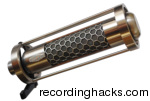 Samar Audio Design TF08
Samar Audio Design TF08
[The TF08 we tested was a prototype; details of the design are still being refined. –Ed.]
The design of this mic harkens back to the earliest cardioid microphones that used two elements: one pure pressure, one pure velocity. The condenser element is positioned just above the velocity element, a ribbon. The sound is exactly what you’d expect from mixing these two types of transducers: open on top and rich down low. The combination not only produces a cardioid pattern, it also provides a balanced sound. There seemed to be a narrow “sweet spot” on the mic where both elements came into focus. On axis it sounded stellar on Corey’s voice. He didn’t have to move much to get out of that sweet spot. It occurred to me that this might offer an advantage if used as a spot mic because of its laser like precision. But if used in a stereo array or on a source that moved around, the mic would need to be used at a distance. Off axis there was a hint of comb filtering. Like using a shotgun mic, positioning the TF08 is critical.
 Samar Audio Design AF11
Samar Audio Design AF11
[As with the TF08, the AF11 we tested was a prototype, with numerous implementation decisions still under development. –Ed.]
This is a single element ribbon microphone that achieves unidirectionality acoustically. Whereas the TF08’s sound was ribbon influenced, this baby has all of the rich low end we love from a ribbon. The AF11 has less air than the TF08, but like Samar’s bidirectional models, this unidirectional ribbon manages to represent a wide frequency spectrum. Some comb filtering was present, though it didn’t shift with movement like the TF08. I can’t figure out how Mark achieved the directionality of this mic in such a compact form, which may be the most impressive achievement of this design.
 Silvia Classics SC-5C
Silvia Classics SC-5C
I am fascinated by this microphone. Based on the classic RCA BK-5, this mic is NOT trying to be cardioid. The baffling and side vents form more of a fan shape: wide on the sides with extreme rejection on the top and bottom. Some situations might really benefit from such a unique pattern. The sound of the mic was also unique. I never once heard a hint of sibilance, yet it had a sizzle to it. Corey did a particularly textured voice that sounded extra gritty on the Silvia, which could be excessive in some cases. Notably, I didn’t hear any comb filtering. I’d like more time with an SC-5C because I suspect it would help some difficult sources sit well in mixes. It might be a great choice to help tame overly shrill sounds yet keep some presence. It wasn’t as rich or flattering as some of the other microphones, but its unique qualities impressed. And it is relatively inexpensive.
 Shure Model 330
Shure Model 330
This classic ribbon does not have a reputation for sounding amazing. So we were stunned that it sounded so good in this comparison. Perhaps it was a good match for Corey’s voice. [Also, it had been restored to its original condition by Dr. Mark Fouxman of Samar Audio Design. –Ed.] Maybe this mic just always needed a quality, high gain preamp like the AEA RPQ. Whatever the reason, we were impressed. It didn’t have the wide bandwidth of the KU4 or TF08; it was a little blanketed on top, lacked bass girth, and had a bit of a honk to it. Some telltale comb filtering was also audible. But it exhibited respectable warmth, with a “forward” sound. I’d be glad to own one for a reasonable price, though I’m not holding my breath because Shure ceased production and they are incredibly difficult to repair by even the most skilled professional.
 Oktava ML-19
Oktava ML-19
Matt McGlynn shared this specimen from his personal collection, another defunct microphone with some history and character. It looked like a side address mic, but it was end address. The low end was a bit flabby, and like the 330, some comb filter effects were noticeable. No matter which voice Corey conjured, the ML-19 made him sound like it was a “head voice.” It might be a good choice for taming a high, harsh, nasal voice. Despite the buttery tones, the mic did exhibit some nice snap. I suspect a little EQ could pull up even more presence. All in all, I’m not convinced that the unique sound of this microphone would be useful often enough to own one.
Why Unidirectional Ribbon Microphones?
 When ribbon microphones were invented, they were a vast improvement, offering great fidelity with wider bandwidth and lower noise than predecessors. Ribbon mikes also offered directionality: sounds directly in front and behind the mic were loud and clear, while sounds above, below and to the sides were rejected. This bidirectional characteristic was created by the difference in path length from the front to the back of the ribbon.
When ribbon microphones were invented, they were a vast improvement, offering great fidelity with wider bandwidth and lower noise than predecessors. Ribbon mikes also offered directionality: sounds directly in front and behind the mic were loud and clear, while sounds above, below and to the sides were rejected. This bidirectional characteristic was created by the difference in path length from the front to the back of the ribbon.
But alas, the bidirectional pattern was not intuitive. Many yearned for a mic that would pick up only what you point it toward, not what’s behind. So engineers researched and developed methods for unidirectionality.
In the last decade we’ve come full circle with the resurgence of ribbon microphones. While we may not consider some of them to be high fidelity microphones, they do render sources uniquely and often beautifully. We love the way they sound. But that counterintuitive bidirectionality is a mental barrier for some people, so engineers are dusting off old techniques to create new ribbon microphones that take advantage of improvements in technology since the early days.
Veteran recording engineers reach for ribbon mikes when recording brass. I love the classic unidirectional  RCA 10001 (upon which the KU4 is based) on saxophone. I like to position the mic above and out front with enough distance to capture the entire body of the instrument (not stuffed in the bell). The sax sounds rich and present without getting too reedy or spitty.
RCA 10001 (upon which the KU4 is based) on saxophone. I like to position the mic above and out front with enough distance to capture the entire body of the instrument (not stuffed in the bell). The sax sounds rich and present without getting too reedy or spitty.
Ribbon microphones were highly prized during the golden age of radio, so it is no surprise many of them sound great on voice. Harsh, shrill voices are often tamed. Sibilance is rare. Mouth noise is less noticeable. Ribbons also seem to smooth out swoops and surges for a smoother, almost compressed sound. Some ribbons lack top end, but some of the better ones have very flavorful presence. They almost never have an open, airy sound, but even the darker ribbon mikes take EQ very well. That is, when you brighten up a ribbon is doesn’t tend to sound as harsh or processed as condenser mikes sometimes do.
Bidirectional mikes have more proximity effect than any other pattern, adding warmth/girth and more likely popping on plosives. Anyone who has used a traditional, bidirectional ribbon mic has experienced this “bass tilt.” However, adding a pressure component to create a unidirectional pattern tames these characteristics considerably. So, a byproduct of reshaping the pattern is a noticeable change in tonal quality. This explains why we tend to find more balance through the spectrum with unidirectional ribbon microphones.
The Sound
 In the end, we reach for certain microphones because of how they sound. Ribbon microphones render audio with unique sonic character. Because the bidirectional pattern can be challenging, designers from years past to present day wrestle physics to bring us ribbon transducers with a more intuitive polar pattern. And in doing so they have created another set of unique sounding microphones. Happy recording.
In the end, we reach for certain microphones because of how they sound. Ribbon microphones render audio with unique sonic character. Because the bidirectional pattern can be challenging, designers from years past to present day wrestle physics to bring us ribbon transducers with a more intuitive polar pattern. And in doing so they have created another set of unique sounding microphones. Happy recording.
Randy Coppinger is a microphone-slinging coffee loyalist who lives and listens in Southern California. Visit Randy online at randycoppinger.com.
For more about how unidirectional ribbon microphones work, see Randy’s companion piece: How A Unidirectional Ribbon Mic Works.
matthew mcglynn
Randy and I want to thank Wes and Julian at AEA for the 77DX, the KU4, and the RPQ preamps. Special thanks also to Mark Fouxman of Samar Audio for giving us the world’s first listen to the TF08 and AF11 prototypes, as well as the loan of his Shure Model 330.
I am sorry to note the untimely passing of Jerry Silvia, inventor of the SC-5C. We send condolences to his family and friends, and the staff of Silvia Classics. Thanks to Theo for coordinating the evaluation loan.
Thanks to engineer Ethan Friedericks and the crew at Igloo for donating their time and facilities for this session.
And finally, I thank Corey Burton for his support, dedication, professionalism, and expertise. This session would have been far less fun and interesting without him! (If you haven’t already, you really should see our previous VO ribbon shootout with Corey. Trust me when I say it is awesome.)
For more on the AEA RPQ preamp used in this review, see Adam Kagan’s recent RPQ500 review.
AEA and Samar Audio will be showing their ribbon mics (and more) at the AES Convention in San Francisco this coming weekend, October 27-29 2012. Bring your questions and your ears and check out these mics in person.
Tags: Corey Burton, Mark Fouxman
Posted in Microphones, Reviews, Shootouts, voiceover | 13 Comments »
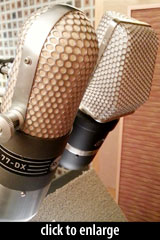
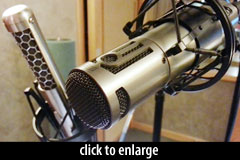
 Shure SM7B
Shure SM7B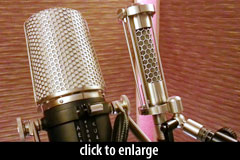



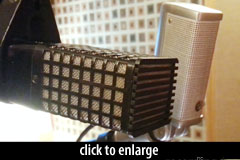



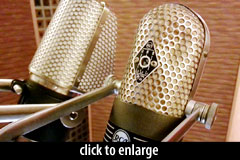

 RCA 77 DX
RCA 77 DX AEA KU4
AEA KU4 Samar Audio Design TF08
Samar Audio Design TF08 Samar Audio Design AF11
Samar Audio Design AF11 Silvia Classics SC-5C
Silvia Classics SC-5C Shure Model 330
Shure Model 330 Oktava ML-19
Oktava ML-19


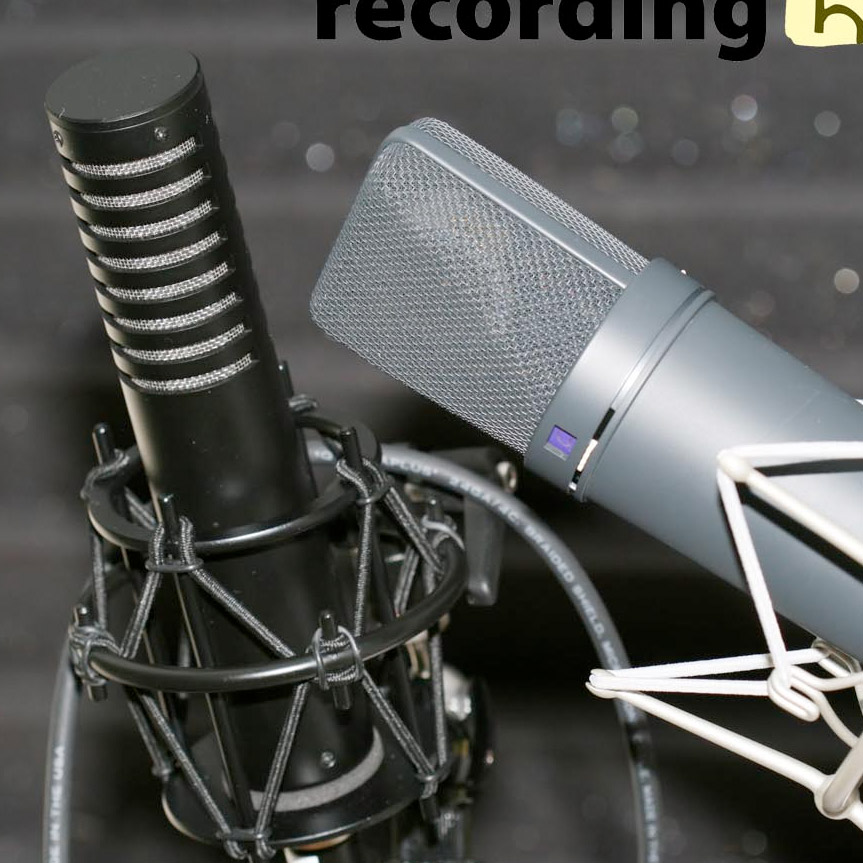
Danny
October 26th, 2012 at 2:04 pm
Check out a 77 on strings, brass, drums, or e. guitars, though!
Danny
October 26th, 2012 at 7:23 pm
Also, the 77D was the sole mic used in the famous Toscannini Beethoven recordings. Count them plentiful, too in Bill Putnam’s studio – seen the Frank Sinatra “very good year” clip in studio? https://www.youtube.com/watch?v=L8WEvrfOJ94
Big Dave
October 28th, 2012 at 9:15 am
I am using firefox and the media players are triggering multiple recordings each time I try to play one.
matthew mcglynn
October 30th, 2012 at 11:41 pm
@Dave, I’ve reported the bug to the audio player developer. It’s a pain in the ass, but out of my control, unfortunately.
James
October 31st, 2012 at 10:55 am
Excellent shootout as always! I’m a big fan of ribbons and this site. I did wonder why Beyer M160s weren’t included? I have a couple and would love to be able to compare.
bern
October 31st, 2012 at 5:27 pm
So, the SM7B is the best unidirectional ribbon mic. The RCA 77 DX sounds great (I used to love to see and hear them on LPs, especially the Folk artists), but most any new mic sounds more useful today.
matthew mcglynn
October 31st, 2012 at 9:43 pm
@James, we’d initially intended to include a couple Beyerdynamics, but in the end I wasn’t able to coordinate the loan. I personally really like the brand (my M99 doesn’t leave my desk) but I couldn’t put it together this time.
Julian
November 1st, 2012 at 9:56 am
@bern: The SM7B is a moving-coil dynamic, not a ribbon mic.
Paul
December 3rd, 2012 at 3:34 pm
@Julian, I think that was just sarcasm. But pitting the SM7b against these ribbons was a great idea: it’s an affordable microphone that, at least for voiceover and vocal application, is difficult to beat. Some people also describe the SM7 as having the “warmth of a ribbon”, to borrow a phrase from another RH review; here we see it’s accurate. Using standard mics as comparisons for other microphones is a good idea, very scientific.
Randy Coppinger
December 3rd, 2012 at 3:42 pm
It may also be worth noting: the SM7B has a low output, similar to a ribbon. The gain required on the preamp for the ribbon microphones and the SM7B was similar.
Robert
June 9th, 2014 at 9:24 am
I just aquired an exceptionally clean 77DX that’s been in storage since 1984. Perhaps this one is different, but it is clean, full, and has very good high frequency response for a vintage ribbon mic. On voice, it requires less EQ than either of my factory matched pair of AEA R-84s. Maybe Wes should re-ribbon his 🙂
Wes Dooley
September 1st, 2014 at 3:25 pm
Robert,
The basic problem with RCA non figure-8 ribbon microphones is that their sound is not as consistent, new or used, as we now expect. Even the ~600 KU3A which Charlie Gant personally hand built in Hollywood for RCA Photofone, were not as consistent as he or we would like. This is part of why the AEA KU4 project took five years.
Jon Sank commented to me in the mid 1990s that no two 77D/DX mics every sounded quite the same, even when new. Jon was in charge of RCA 77 production for the decade before RCA shut the division down in 1976 as being too small to bother with. Drummer Jim Keltner went through seven 77 D/DX mics before he found an OK match to a friend’s 77 that he liked.
Jon and I discussed reissuing the 77, but finally decided that there are lots of them available used. We finally decided that a KU4 would be more useful than trying to solve a host of problems with a 77E version. While Dr. Takeo Yamamoto (later president of Pioneer Electronics” was a transducer researcher at NHK, they tackled the 77’s problems. I have several versions of these mics with NHK’s improvements. Dr. Yamamoto had described NHK’s improvements to the shutter mechanism and the impedance tube between the ribbon and the labryinth. None of these changes fully solved the problems inherent to the RCA 77 D and DX mics.
I have now been building professional audio equipment for 50 years, and much of what I am relaying to you is from face to face conversations, that predate the wonderful written documentation of emails.
I hope what I remember is helpful.
Wes Dooley / AEA Ribbon Mics and Preamps
Olle
August 28th, 2015 at 4:35 am
There must’ve been something wrong with the DX77’s in this test. A DX77 in good condition, with a healthy ribbon, is everything b u t murky. You can actually even get great sibilance using the right high-quality preamp.
I can’t say anything about “ugly” though, as its highly individual. But murky… come on?